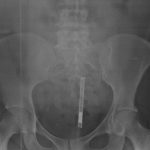It’s always interesting to review the trauma literature of days gone by to see where we’ve been and how it impacts where we are today in trauma care. Here are a few articles from the Jan 1990 Journal of Trauma (Volume 30 Number 1) worth commenting on:
Efficacy of Liver Wound Healing by Secondary Intent. Dulchavsky et al, page 44-48. This paper compared wound healing using tensile strength in pigs and dogs. The authors compared primary operative closure, closure with an omental buttress, and healing by secondary intention. They found that the strength of secondary healing equaled or exceeded that in both types of operative repair by 6 weeks post-injury. This paper and several similar ones laid the groundwork for our understanding of solid organ healing and lend weight to the somewhat arbitrary guidelines of resuming full physical activity after 6 weeks.
Intestinal Injuries Missed by Computed Tomography. Sherck et al, page 1-7. The authors retrospectively looked at 10 CT scans done over a 9 year period that were done in patients who eventually were found to have an intestinal injury. The injury became apparent in 2 hours to 3 days after the traumatic event. Even when the authors knew that a bowel injury was present, they could definitively diagnose the problem on the initial CT in only 2. The authors concluded that CT could not reliably detect these injuries. Little has changed since this paper was published, even though the scan technology has improved greatly (1 or 2 slice scanners in 1990, 16-64 slices now). We have gotten better at detecting bowel injury with better resolutions, but the diagnosis still remains a clinical one.
Techniques of Splenic Preservation Using Fibrin Glue. Shoemaker et al, page 97-101. The senior author first described the use of fibrin glue in splenic injury in 1983, and continued to investigate it over the next 7 years. This paper was the largest human series at the time. The authors found that it limited blood loss and transfusions, although there was no actual control group. They found that it increased splenic salvage rates to 86% in operative cases, and repeat CT did not show rebleeding or abscess formation. This study added a new technique to the trauma surgeon’s armamentarium in dealing with solid organ injury. Although later studies did find a modest increase in abscess formation, the technique remains a viable alternative when operatively managing solid organ injury. Overall, it is not used as much now because nonoperative management has become quite refined, with a success rate of about 93%.


